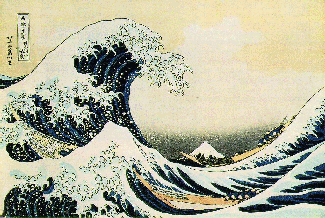 |
||
| Cosmic Inflation | ||
|
Katsushika Hokusai (1760-1849), The Great Wave (1823-29) Cosmic inflation is a process of extreme accelerated expansion of the Universe. According to the standard inflationary model (proposed in 1981 by A. Guth and elaborated on by many others) the nascent universe passed through a phase of exponential expansion that was driven by a negative-pressure vacuum energy density (vacuum energy is an underlying background energy that exists in space even when devoid of matter). The high vacuum energy density drove this accelerated expansion during the very early moments of the Big Bang. This expansion is responsible for the continuing Hubble expansion of the Universe, its present huge size, its relative homogeneity and isotropy, and its spatial flatness. Inflation also explains the origin of the large-scale structure of the cosmos. The quantum fluctuations of the inflation field produced the ripples in space-time, which are thought to be the primordial seeds of the galaxy formation. _____________________________________________________________________________________ Inflation is one of the most popular methods known for generating an isotropic and homogeneous universe. The basic idea is that the universe, which is expanding now with some time dependent scale factor a(t), starts expanding faster and faster. Expansion means that the scale factor changes with time, d a(t)/dt is nonzero. For inflation, this change in the scale factor changes with time as well, that is, the scale factor accelerates: d2 a(t)/ d t2 > 0 . The effect of this is to dilute away all the inhomogeneities in space, such as monopoles predicted by many high energy theories (one of the early motivations), or any other sort of fluctuations. The number density of particles goes to zero, since space is expanding so fast. Read more from Joanne Cohn.
What is the Inflation Theory? WMAP site
|
||
